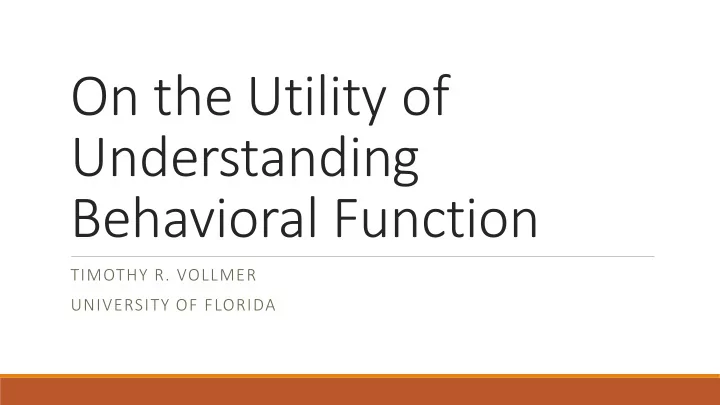

On the Utility of Understanding Behavioral Function TIMOTHY R. VOLLMER UNIVERSITY OF FLORIDA
Co-author Crystal Slanzi, University of Florida
Understanding function By understanding the literature By conducting a good assessment By conducting a functional analysis
Considerations in a school setting Before conducting an FA, be sure that medical concerns are addressed and that safety of student and staff is assured. For severe behavior, a school setting might not be appropriate for an FA. Differentiating between socially reinforced behavior and automatically reinforced behavior is important (see Querim et al., 2013). If socially reinforced, the literature is showing us that the use of positive reinforcement as treatment is important whether the behavior is maintained by positive or negative reinforcement (e.g., Slocum & Vollmer, 2015). There is a simple rule of thumb to follow for treatment: minimize reinforcement for problem behavior, maximize reinforcement for appropriate alternative behavior (e.g., Athens & Vollmer, 2010). If automatically reinforced, the prognosis is usually not as good, but recent work is showing that such behavior falls into at least two categorical types. For one, the prognosis is actually quite good (Hagopian et al., 2015).
Extensions of Querim et al. (2015)
No Interaction C1 C2 100 % of intervals with 80 V. Stereotypy 60 40 20 0 0 5 10 15 20 25 1-min bins
NI E C E C NI TX 100 AGG, SIB per Minute 2 80 Compliance 60 1 40 20 0 0 0 30 60 1-min bins
References Athens, E.S. & Vollmer, T.R. (2010). An investigation of differential reinforcement of alternative behavior without extinction. Journal of Applied Behavior Analysis, 43 , 569-589. Hagopian, L.P., Rooker, G.W., & Zarcone, J.R. (2015). Delineating subtypes of self-injurious behavior maintained by automatic reinforcement. Journal of Applied Behavior Analysis, 48, 523-543. Querim, A.C., Iwata, B.A., Roscoe, E.M., Schlichenmeyer, K.J., Ortega, J.V., & Hurl, K.E. (2013). Functional analysis screening for problem behavior maintained by automatic reinforcement. Journal of Applied Behavior Analysis, 46, 47-60. Slocum, S.K. & Vollmer, T.R. (2015). A comparison of positive and negative reinforcement for compliance to treat problem behavior maintained by escape. Journal of Applied Behavior Analysis, 48, 563-74
Recommend
More recommend